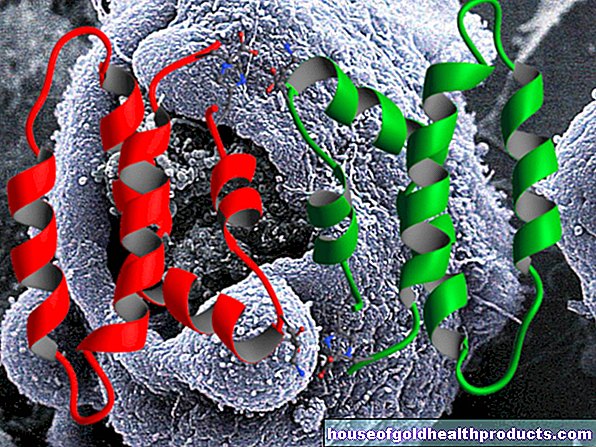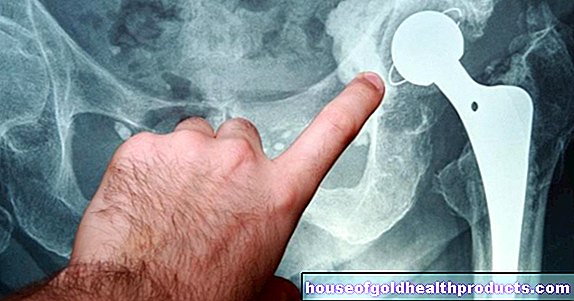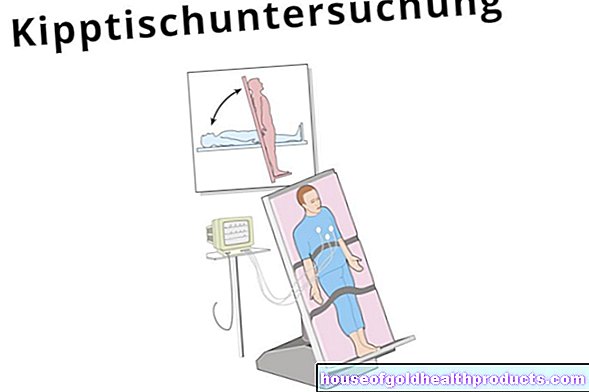Macular edema
All content is checked by medical journalists.Macular edema is an eye disease of the retina that leads to impaired vision and, if left untreated, can lead to blindness. Swelling or fluid accumulation (edema) occurs at the point of sharpest vision (macula) of the retina. It has various causes: In diabetes mellitus, diabetic macular edema occurs as a result of changes in the blood vessels in the eye. The cystoid macular edema usually occurs after surgical interventions such as cataract operations. If it is recognized and treated at an early stage, therapy maintains or improves vision. Read more here!
ICD codes for this disease: ICD codes are internationally recognized codes for medical diagnoses. They can be found, for example, in doctor's letters or on certificates of incapacity for work. H35
Brief overview
- Description: Accumulation of fluid (edema) at the point of sharpest vision (macula) of the retina, occurs relatively frequently in diabetes mellitus, leads to loss of vision if untreated
- Treatment: Depending on the cause, with laser therapy, injections into the eye, rarely with eye drops
- Prognosis: If diagnosed early, usually treatable; if left untreated, loss of vision is possible
- Symptoms: Often appear insidious, blurred and blurred vision
- Causes: Diabetes mellitus or disorders of the retinal-blood barrier, as well as operations on the eye and inflammation
- Diagnosis: Based on the symptoms, ophthalmological examination using a slit lamp, optical coherence tomography and fluorescein angiography
- Prevention: the best possible therapy for diabetes mellitus, regular retinal checks, and risk factors in eye surgery
What is macular edema?
Macular edema is an eye disease. This results in an accumulation of fluid (edema) or swelling of a certain area of the retina, the so-called macula. The macula, also known as the “yellow spot”, is defined as the point of sharpest vision and is located in the center of the retina. There are different types of macular edema: A distinction is made between diabetic macular edema and cystoid macular edema. If cystoid macular edema occurs after cataract surgery, doctors refer to it as Irvine-Gass syndrome.
While cystoid macular edema occurs less and less due to improved surgical techniques, the number of diabetes diseases is increasing. According to the Robert Koch Institute, the numbers for the incidence of diabetes mellitus have increased almost tenfold since the 1960s. In the age group over 65 in particular, around one in five people has diabetes mellitus (women: 17.6%, men: 21.1%). Diabetic macular edema is the leading cause of decreased vision or blindness in people between the ages of 20 and 65.
What is diabetic macular edema?
Diabetes mellitus leads to long-term vascular damage, including the small blood vessels that supply the retina of the eye. If this complication occurs in people with diabetes, doctors refer to it as diabetic retinopathy. If left untreated, retinal disease caused by diabetes leads to blindness in many cases.
The visual impairment caused by diabetic macular edema is caused by accumulation of fluid on the retina and by retinal thickening of the macular center or in its vicinity. The risk of blindness depends on how severely the vessels of the retina are affected and on which part of the macula the edema occurs: the closer it is to the macular center, the more serious the loss of vision.
What is cystoid macular edema?
Cystoid macular edema often occurs after cataract operations. In the case of a cataract (cataract), the originally clear lens of the eye is cloudy and is surgically replaced by an artificial lens. After operations on the eye, especially after cataract operations, macular edema is called Irvine-Gass syndrome - after the two doctors who were the first to describe the syndrome.
After the operation, fluid builds up in the retina of the eye, which builds up in small cysts or vesicles in the macula. In severe cases, several of these cysts cluster together and cause deep damage to the retina.
Cystoid macular edema may also develop from other causes such as inflammation.
H2: How can macular edema be treated?
The treatment of macular edema depends on the cause, for example diabetes mellitus or cataract surgery.
Treatment of diabetic macular edema
First and foremost is the treatment of the underlying disease, diabetes mellitus, whereby the control and optimal setting of blood sugar and blood pressure are particularly important.
If there is diabetic macular edema, the doctor will base the treatment options on the severity and severity of the macular edema. There are basically two options for treating diabetic macular edema:
Laser therapy
In the treatment of diabetic macular edema, in which the retinal center (fovea) is not involved, laser treatment is used. The primary aim of this treatment is to stop the progression of the visual disorder and to stabilize visual acuity.
Laser therapy is usually carried out on an outpatient basis in specialized ophthalmological practices or eye clinics. Before the procedure, the eye is numbed with drops, so that the treatment is usually painless. There is occasional pain when the doctor has to work close to the optic nerve with the laser.
Intravitreal injections / syringes in the eye
If the retinal center (fovea) is affected in diabetic macular edema, doctors usually suggest injecting medication into the eye first. The aim of this treatment is that the macular edema regresses and the eyesight is improved again.
This treatment is also usually carried out on an outpatient basis in specialized ophthalmological practices or eye clinics. As a rule, the intravitreal syringes are not painful because the eye is anesthetized before the injection. So-called VEGF inhibitors are primarily injected.
VEGF stands for "Vascular Endothelial Growth Factor", ie vascular endothelial growth factor. This factor ensures the formation of new blood vessels and is inhibited by the injection of the VEGF inhibitors. These drugs are among the newer therapies for macular edema.
In most cases, the injection is given monthly, up to twelve times a year. The therapy may be carried out over a period of several years; the number of syringes usually decreases each year.
Alternatively, for example if there is an increased risk of stroke or if the VEGF inhibitors do not show the desired effect after a certain time (usually after three to six injections), the doctor often uses corticosteroids (cortisone). Since diabetes mellitus is associated with many inflammatory processes, the corticosteroids also have an anti-inflammatory effect on diabetic macular edema.
The duration of therapy is much shorter here: those affected receive an injection from the doctor every three to six months. There is now an implant with corticosteroids that lasts up to three years.
At the same time, the therapy also has side effects: The risk of increased intraocular pressure and the development of a cataract must be weighed with the doctor.
Laser therapy may also be used or additionally used in diabetic macular edema with involvement of the retinal center.
Treatment of cystoid macular edema
Most cases of cystoid macular edema occur after cataract surgery. Many heal on their own and do not need therapy. However, a doctor must regularly examine the development. Cystoid macular edema is caused, among other things, by inflammation or blocked blood vessels. If this is determined, the doctor adjusts the therapy individually.
If the cystoid macular edema has to be treated, the ophthalmologist may, for example, prescribe anti-inflammatory eye drops containing cortisone or give cortisone injections into the eye.
What is the prognosis for macular edema?
The cause and time of diagnosis influence the prognosis of macular edema. The earlier a diagnosis is made, the faster the therapy and the more favorable the prognosis.
Due to the improved surgical techniques, cystoid macular edema rarely occurs, for example after cataract surgery. In most cases the chances of recovery are good under the therapy, and in many cases the cystoid macular edema will heal by itself. Diabetes mellitus, other pre-existing conditions such as high blood pressure or complications during the operation increase the risk of cystoid macular edema.
In the case of diabetic macular edema, the early diagnosis of the macular edema, the response to therapy and the initial situation (previous illnesses, etc.) of the person affected are decisive factors for the prognosis of the disease. With appropriate treatment, vision stabilizes in many cases, and vision improves again in some cases.
What are the symptoms of macular edema?
The symptoms of macular edema depend, among other things, on the severity and severity. Many of those affected notice changes, especially when reading or driving, their vision is suddenly blurred and out of focus. The sight of spots or impaired perception of colors also occurs in patients with macular edema. In some cases symptoms do not show up, in others they start slowly and cause only mild visual disturbances. Often the signs of macular edema are noticed late.
In particular, if you have diabetes mellitus, it is advisable to have regular checkups for macular edema by your ophthalmologist.
What is the cause of macular edema?
There are several causes of macular edema. Doctors assume that diabetic macular edema is primarily caused by a disruption of the so-called blood-retinal barrier. This describes the semi-permeable separation (barrier) between the retina and the blood vessels that supply it. If it is disturbed, fluid accumulation, thickening and vascular damage occur, which then lead to macular edema.
In addition, different characteristics of the underlying disease diabetes mellitus play a role. Diabetic macular edema occurs more frequently the longer the diabetes persists and the more severe the diabetic retinopathy becomes. The inflammatory processes that take place in the body in diabetes also seem to have an influence on the development of macular edema.
Why cystoid macular edema (CME) occurs after surgery has not yet been fully clarified. Doctors currently consider the main cause to be the presence of inflammatory processes and messenger substances that are released during surgery and also affect the permeability of blood vessels.
How is macular edema diagnosed?
The ophthalmologist determines macular edema based on the symptoms described, an eye test and various ophthalmological examinations. The retina can be viewed and assessed and macular edema diagnosed with a slit lamp (a special microscope used by ophthalmologists).
Furthermore, a kind of ultrasound examination, the so-called optical coherence tomography (OCT), is carried out under certain circumstances. On the basis of this, it is possible for the doctor to assess the eye tissue more precisely. In many cases the statutory health insurances do not undertake this examination. OCT is often used to monitor the course of macular edema.
Using fluorescein angiography (also known as fluorescence angiography), the attending physician is primarily able to check the blood vessels and their function. This examination is mainly used at the beginning to diagnose and plan therapy for macular edema. In order to perform fluorescein angiography, the doctor must, among other things, administer a certain dye through a vein in the arm.
For these examinations, the pupils must be dilated beforehand. This is done by giving certain eye drops. Remember that your eyes may be sensitive to light during this time; sunglasses can help. It is also advisable not to drive a car or bike for a few hours afterwards until the effects of the drops wear off.
How can you prevent macular edema?
The prevention of diabetic macular edema takes place primarily through the treatment of the underlying disease, diabetes mellitus. Regular checks and good blood sugar and blood pressure control are essential here. In addition, regular check-ups by the ophthalmologist for prophylaxis of macular edema are part of it.
In the case of cystoid macular edema, which occurs mainly after cataract or other eye operations, a careful preliminary examination is important. In this regard, your surgeon will pay particular attention to risk factors. These include:
- Previous illnesses such as diabetes mellitus or high blood pressure
- Anatomical peculiarities that complicate the operation
- A history of certain previous diseases of the eye such as uveitis (inflammation of the middle skin of the eye) or retinal vein obstruction
- Certain drugs (e.g. prostaglandin analogs for glaucoma)
In these cases, it is advisable to monitor the course closely in order to identify possible development of macular edema at an early stage.
Tags: sports fitness Baby Child alternative medicine





























